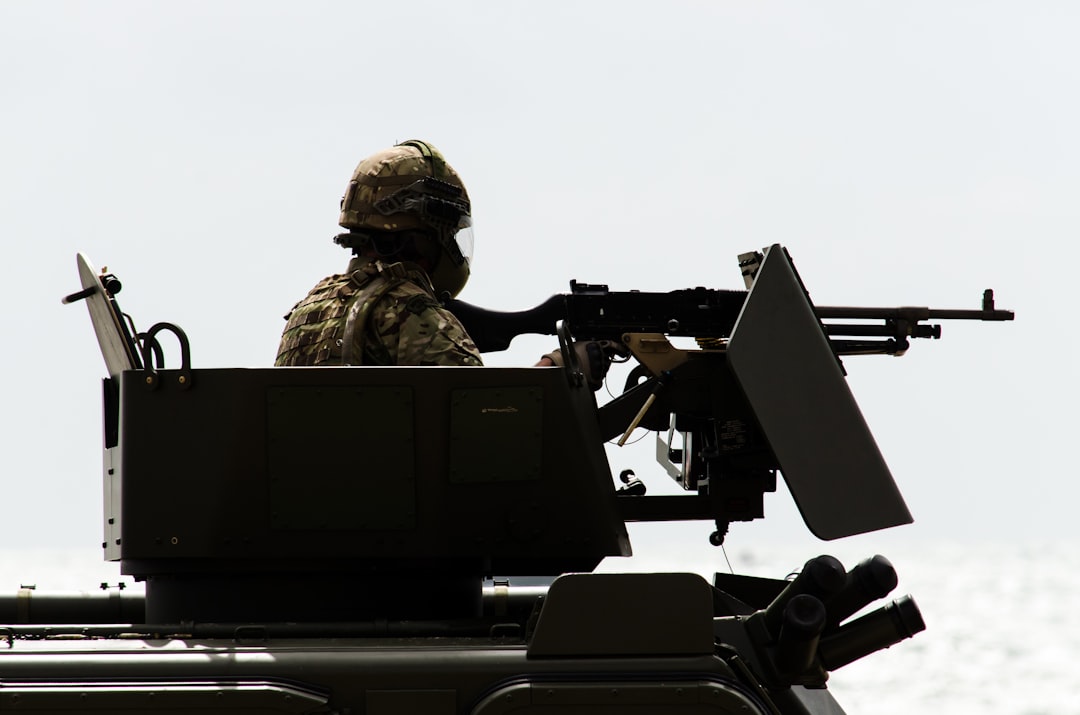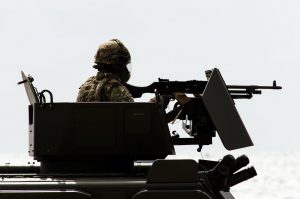Enhanced Combat: Future Soldier Tech Innovations
Discover the future of warfare with cutting-edge soldier tech innovations. Dive into what’s next for combat. Explore the future today!
Enhanced Combat Gear
Advanced Body Armor
Future soldier technology is revolutionizing the concept of body armor, making it lighter, stronger, and more adaptable. Advanced materials such as graphene and carbon nanotubes are being utilized to create armor that offers superior protection against ballistic threats while maintaining flexibility and comfort.
This new generation of body armor is designed to provide maximum mobility, allowing soldiers to move freely in various combat scenarios.
Moreover, smart textiles integrated into the armor can monitor the soldier’s vital signs, providing real-time health data to medics and command centers. This integration ensures that soldiers receive immediate medical attention when necessary, potentially saving lives on the battlefield.
Integrated Communication Systems
Enhanced combat gear includes cutting-edge communication systems that keep soldiers connected on the battlefield.
These systems are embedded within the helmets and uniforms, allowing for seamless communication between team members and command units. With the help of advanced radio and satellite technologies, soldiers can maintain clear and secure lines of communication even in the most challenging environments.
Additionally, augmented reality (AR) visors are becoming a standard feature, providing soldiers with real-time data overlays, such as maps, enemy positions, and mission objectives.
This technology enhances situational awareness and decision-making capabilities, giving soldiers a tactical advantage.
Exoskeleton Suits
Exoskeleton suits are a pivotal component of enhanced combat gear, offering soldiers increased strength and endurance. These powered suits are designed to augment the physical capabilities of soldiers, enabling them to carry heavier loads and perform physically demanding tasks with ease.
By reducing fatigue, exoskeletons enhance combat effectiveness and prolong operational capabilities.
Furthermore, exoskeletons are equipped with sensors and actuators that respond to the soldier’s movements, providing intuitive control and support. This technology not only improves performance but also reduces the risk of injuries, ensuring that soldiers remain combat-ready for longer durations.
Advanced Weaponry
The integration of advanced weaponry into enhanced combat gear is transforming the battlefield.
Future soldiers are equipped with smart weapons that feature precision targeting systems, allowing for accurate engagement of targets at extended ranges. These weapons are often equipped with biometric sensors, ensuring that only authorized personnel can operate them.
Additionally, modular weapon systems enable soldiers to adapt their firearms to various combat situations, enhancing versatility and effectiveness.
With the incorporation of AI and machine learning, these weapons can analyze and adapt to changing combat environments, providing soldiers with an unprecedented level of firepower and control.
Advanced Weapon Systems
Smart Firearms
Smart firearms represent a significant leap forward in weapon technology, integrating digital enhancements to improve accuracy and efficiency. These weapons often feature advanced targeting systems, which use laser rangefinders and ballistic computers to calculate the optimal firing solution.
Additionally, smart firearms can be equipped with biometric security features, ensuring that only authorized users can operate them.
Another key aspect of smart firearms is their connectivity. Many of these weapons are designed to interface with other digital systems, allowing soldiers to receive real-time data and updates directly through their weapon’s display.
This connectivity enhances situational awareness and enables more coordinated operations on the battlefield.
Directed Energy Weapons
Directed energy weapons (DEWs) are a revolutionary category of advanced weapon systems that use focused energy, such as lasers or microwaves, to incapacitate or destroy targets. Unlike traditional weapons that rely on kinetic or explosive force, DEWs offer precision targeting with minimal collateral damage.
This makes them particularly valuable in urban combat scenarios where minimizing civilian casualties is a priority.
One of the primary advantages of DEWs is their speed. Since they operate at the speed of light, these weapons can engage targets almost instantaneously, providing a significant tactical advantage.
Furthermore, DEWs have the potential for virtually unlimited ammunition, as long as there is a power source available, making them a cost-effective solution for sustained operations.
Autonomous Weapon Systems
Autonomous weapon systems represent the forefront of artificial intelligence integration in military technology. These systems are capable of identifying, tracking, and engaging targets with minimal human intervention.
By leveraging advanced algorithms and machine learning, autonomous weapons can adapt to dynamic combat environments, making real-time decisions based on the data they receive.
While the deployment of autonomous weapon systems raises ethical and legal considerations, their potential to enhance operational efficiency and reduce human risk is undeniable. These systems can perform tasks that are too dangerous or complex for human soldiers, such as clearing mines or conducting reconnaissance in hostile territories.
Hypersonic Weapons
Hypersonic weapons are designed to travel at speeds exceeding Mach 5, making them incredibly difficult to detect and intercept.
These weapons can be used to deliver conventional or nuclear payloads over long distances with unprecedented speed and precision. The development of hypersonic technology is a critical focus for military forces worldwide, as it promises to reshape the strategic landscape.
The key to hypersonic weapons’ effectiveness lies in their ability to maneuver at high speeds, evading traditional missile defense systems.
This capability not only enhances their survivability but also increases the likelihood of mission success. As research and development in this field continue, hypersonic weapons are expected to become a cornerstone of future military arsenals.
Tactical Communication Solutions
Advanced Communication Devices
In the realm of future soldier technology, advanced communication devices are pivotal.
These devices are designed to provide seamless, real-time communication in diverse and challenging environments. Equipped with cutting-edge technology, they ensure that soldiers remain connected with their units and command centers, regardless of geographical barriers.
Modern communication devices are compact, lightweight, and durable, making them suitable for the demanding conditions faced by soldiers.
They often incorporate features such as noise cancellation, secure encryption, and GPS tracking, which enhance operational efficiency and security.
Integration with Wearable Technology
Integration with wearable technology is a key aspect of tactical communication solutions. Future soldier systems are increasingly incorporating wearable devices that provide vital information directly to the soldier.
These devices can include smart helmets, wrist displays, and augmented reality glasses, all of which are designed to enhance situational awareness.
By integrating communication systems with wearable technology, soldiers can receive real-time updates, maps, and mission-critical information without the need for handheld devices. This hands-free communication capability allows for greater mobility and focus during missions.
Network Resilience and Security
Network resilience and security are paramount in tactical communication solutions.
Future soldier technology must ensure that communication networks are robust and capable of withstanding cyber threats and physical disruptions. Advanced encryption protocols and secure communication channels are essential to protect sensitive information.
Additionally, network resilience is achieved through the use of mesh networks and satellite communications, which provide redundancy and ensure connectivity even in remote or hostile environments.
This ensures that soldiers can maintain communication links even when traditional infrastructure is compromised.
Artificial Intelligence and Data Analytics
Artificial intelligence (AI) and data analytics are transforming tactical communication solutions. AI-driven systems can analyze vast amounts of data in real-time, providing soldiers with actionable insights and predictive analytics.
This enhances decision-making and allows for more effective mission planning and execution.
Data analytics also play a crucial role in monitoring communication networks, identifying potential threats, and optimizing resource allocation. By leveraging AI and data analytics, future soldier technology can deliver smarter, more efficient communication solutions.
Next-Gen Training Simulations
Immersive Virtual Reality Environments
Next-gen training simulations are revolutionizing soldier preparation through the use of immersive virtual reality (VR) environments.
These simulations enable soldiers to experience realistic combat scenarios without the risks associated with live training exercises. By leveraging advanced VR technology, soldiers can practice tactical maneuvers, decision-making, and teamwork in a controlled yet highly realistic setting.
This approach not only enhances learning outcomes but also allows for the repetition of scenarios, ensuring that soldiers are well-prepared for a variety of situations.
Artificial Intelligence Integration
The integration of artificial intelligence (AI) into training simulations is another key advancement in future soldier technology. AI-driven simulations can adapt to the actions of individual soldiers, providing personalized feedback and dynamically altering scenarios to challenge trainees.
This adaptability ensures that soldiers are constantly engaged and learning at an optimal pace. Moreover, AI can analyze performance data to identify areas for improvement, making training more efficient and targeted.
Augmented Reality for Real-World Applications
Augmented reality (AR) is being utilized to bridge the gap between virtual simulations and real-world applications.
By overlaying digital information onto the physical environment, AR allows soldiers to train in actual locations while receiving real-time data and guidance. This technology is particularly beneficial for urban warfare training, where understanding the intricacies of a specific environment can be crucial.
AR enhances situational awareness and helps soldiers develop the skills needed to navigate complex terrains effectively.
Collaborative Training Platforms
Next-gen training simulations also emphasize the importance of collaboration and teamwork. Collaborative platforms enable soldiers from different locations to participate in joint exercises, fostering communication and coordination skills.
These platforms support a range of training scenarios, from small unit tactics to large-scale operations, ensuring that soldiers are prepared for diverse missions. By simulating joint operations with allied forces, these platforms also enhance interoperability, a critical component of modern military strategy.
Real-Time Performance Analytics
Real-time performance analytics are integral to the effectiveness of next-gen training simulations.
By providing immediate feedback on a soldier’s actions and decisions, these analytics help trainees understand their strengths and areas for improvement. This data-driven approach allows for continuous refinement of training programs, ensuring that they remain relevant and effective.
Additionally, performance analytics can be used to tailor training to the specific needs of individual soldiers, maximizing their potential and readiness for future challenges.
FAQ
Q1: What are the cost implications of adopting Future Soldier Technology?
A1: The cost of adopting Future Soldier Technology can vary significantly depending on the complexity and scope of the technology being implemented. Initial expenses may include purchasing advanced equipment, such as wearable tech, communication devices, and augmented reality systems. Additionally, there are costs associated with training personnel to effectively use these technologies. Maintenance and upgrades also contribute to ongoing expenses. However, these costs can be offset by the potential for increased operational efficiency, improved safety, and enhanced mission success rates. Organizations should conduct a thorough cost-benefit analysis to understand the long-term financial implications and potential return on investment.
Q2: How accessible is Future Soldier Technology for non-engineers?
A2: Future Soldier Technology is increasingly being designed with user-friendliness in mind, making it more accessible to non-engineers. Many systems now feature intuitive interfaces and automated functions that simplify operation. Training programs are often developed to bridge the gap for users without technical backgrounds, focusing on practical application rather than technical intricacies. Furthermore, ongoing support and resources are typically available to assist users in mastering these technologies. As the technology continues to evolve, manufacturers are prioritizing accessibility to ensure that a broader range of personnel can effectively utilize these tools without requiring extensive engineering expertise.
Q3: What are the main implementation challenges of Future Soldier Technology, and how can they be addressed?
A3: Implementing Future Soldier Technology presents several challenges, including integration with existing systems, cybersecurity concerns, and the need for comprehensive training. Compatibility with current tools and infrastructure can be a significant hurdle, requiring careful planning and possibly the development of custom solutions. Cybersecurity is another critical issue, as advanced technologies can be vulnerable to hacking and other threats. Organizations must invest in robust security measures and protocols to protect sensitive data. Additionally, effective training programs are essential to ensure that personnel can operate new technologies efficiently. Addressing these challenges requires a strategic approach, involving collaboration between technology providers, military planners, and IT specialists to ensure seamless integration and operation.
Takeaway
“Ready to supercharge your productivity with our AI tool? Try it now and revolutionize your workflow! Subscribe for the latest tech trends and stay ahead of the curve. Join our vibrant community to discuss all things tech – your next big idea could be just a conversation away. Let’s innovate together!” According to a report by Bloomberg,











Comments